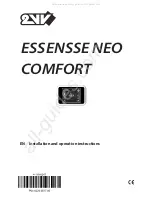
Page 13
VTX series instructions
All speed controllers should only be used with good
quality motors. Old, dirty motors can have damaged,
worn brushgear and this causes arcing. On occasion
arcs at the brushes can cause seemingly random
controller failure. Fortunately this effect is quite rare,
but it’s best to be careful.
Motor capacitor:
Ideally the motor should include
an internal suppression capacitor, a ceramic type of
10n value is suitable. If the motor does not include
this you are advised to fit one across the brushes as
close as possible to the motor body as shown on page
6. The controller will work without this capacitor, but
it can lengthen the life of the system.
A word of warning: many car type motors have the
chassis connected to one terminal. Take great care
with these as you could easily short the controller out
- which would be fatal. It is best to avoid these
motors. Otherwise either make sure the motor is
mounted on insulation (including the drive shaft), or
make certain that no other point of the control system
can be earthed to chassis. If in doubt contact 4QD.
Most modern d.c. motors use permanent magnets.
These are the best for battery operation. However,
other types can be used: at 4QD we regularly use a
12v car starter motor for testing (even with our 24v
150 amp drives) since these are a far worse load than
is ever likely to be met. Into such a motor (stalled)
the controllers simply deliver their maximum current
and get hot. It is virtually impossible to damage the
controllers by an unsuitable motor (the controller will
simply get hot quickly), so don’t be afraid to
experiment.
There is no reason why you cannot use a 24v motor
from 12 volts - it will only go at half its design speed.
Also, if you use a 12 volt motor from 24v, it will go
at twice its rated speed. Since the VTX is current
limited you won’t overload the 12v motor, provided
it can handle the available (limited) current.
Shunt wound motors can be used if the field
winding can be separated. Connect the field winding
permanently across the supply and control the
armature winding: the shunt would motor then
behaves like a permanent magnet motor.
Series wound motors may also be used but they
cannot give dynamic braking and are very inefficient
at low speeds so are not ideal. To use them with the
VTX series a modification must be made so the field
can be correctly connected into the relay circuitry:
contact 4QD.
You can reverse a field-energised motor by simply
swapping over the field windings. You should not do
this when the motor is rotating as armature currents
will then be very high. The field will draw much less
current than the armature so a much smaller switch
will suffice. A field energised motor, used on the
The rated current output of the controllers is with the
heatsink hot. When cold they will give considerably
more current. Thus the 40 amp version will in fact
give about 55 amps when cold. This is OK because
the MOSFETs used are rated at 60 amps continuous
with a case temperature of 25°C. As the MOSFETs
warm up their allowable current reduces so that at a
case temperature of 100°C they can (only!) handle
42 amps each continuously. The current limiting used
in 4QD’s controllers senses the MOSFET
temperature and automatically adjusts as the
MOSFETs heat up. However, running the controllers
at full current will cause speedy heating so the
allowable continuous current will depend on the
external heatsinking.
Steel is not a good heatsink material: heat does not
flow easily in steel. Aluminium or copper is far
better. If you have a steel plate, sandwich an
aluminium sheet between the steel and the VTX to
spread the heat. For really arduous use we suggest
heatsink compound between the VTX’s heatsink and
your own: this helps heat flow across the join. Make
sure both surfaces are flat and free of grit.
The VTX-75 incorporates a thermal sensor (optional
on other models) which cuts back the output current
if the controller gets too hot. The VTX-75 cuts back
to about 20 amps, when the MOSFETs will dissipate
about 20 watts. This is still enough to overheat the
controller if no external heatsink is used, so don’t rely
on it!
13: Heat & Heatsinking
14: Choice of motor


































